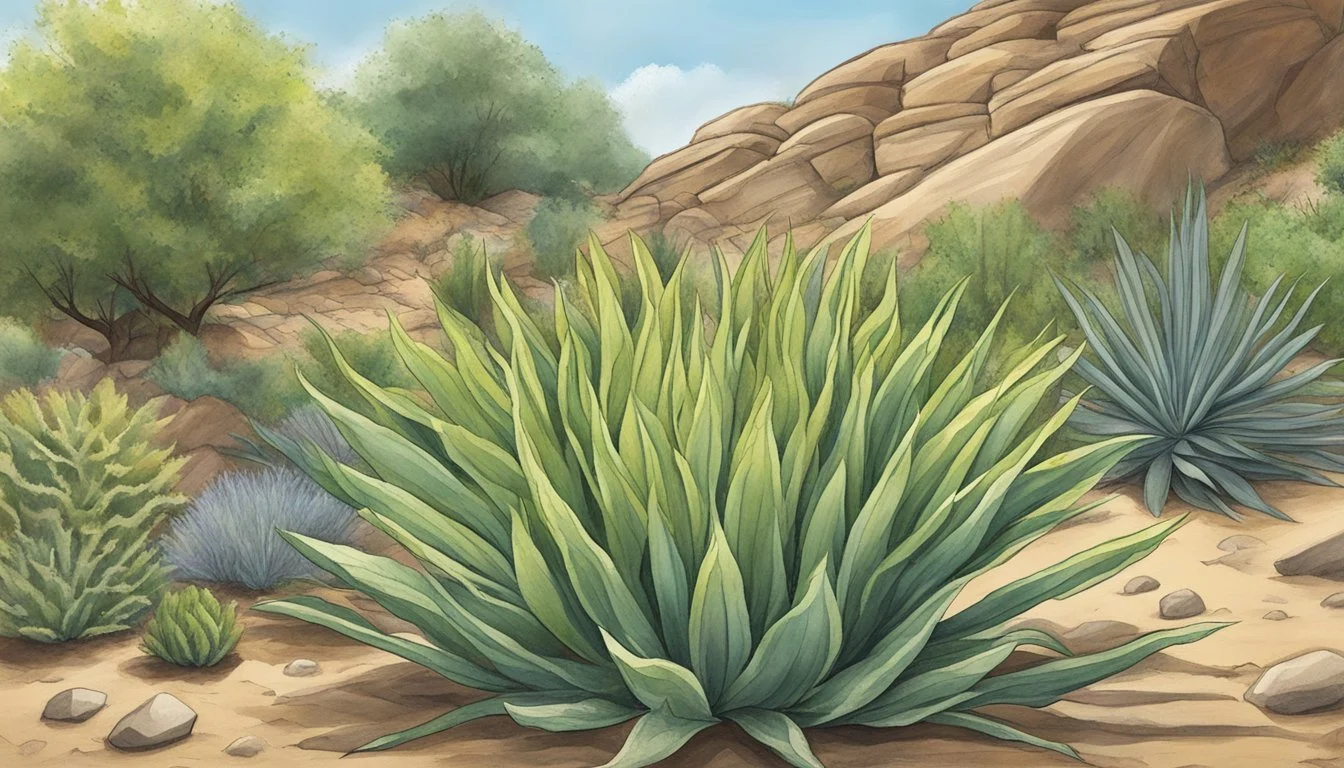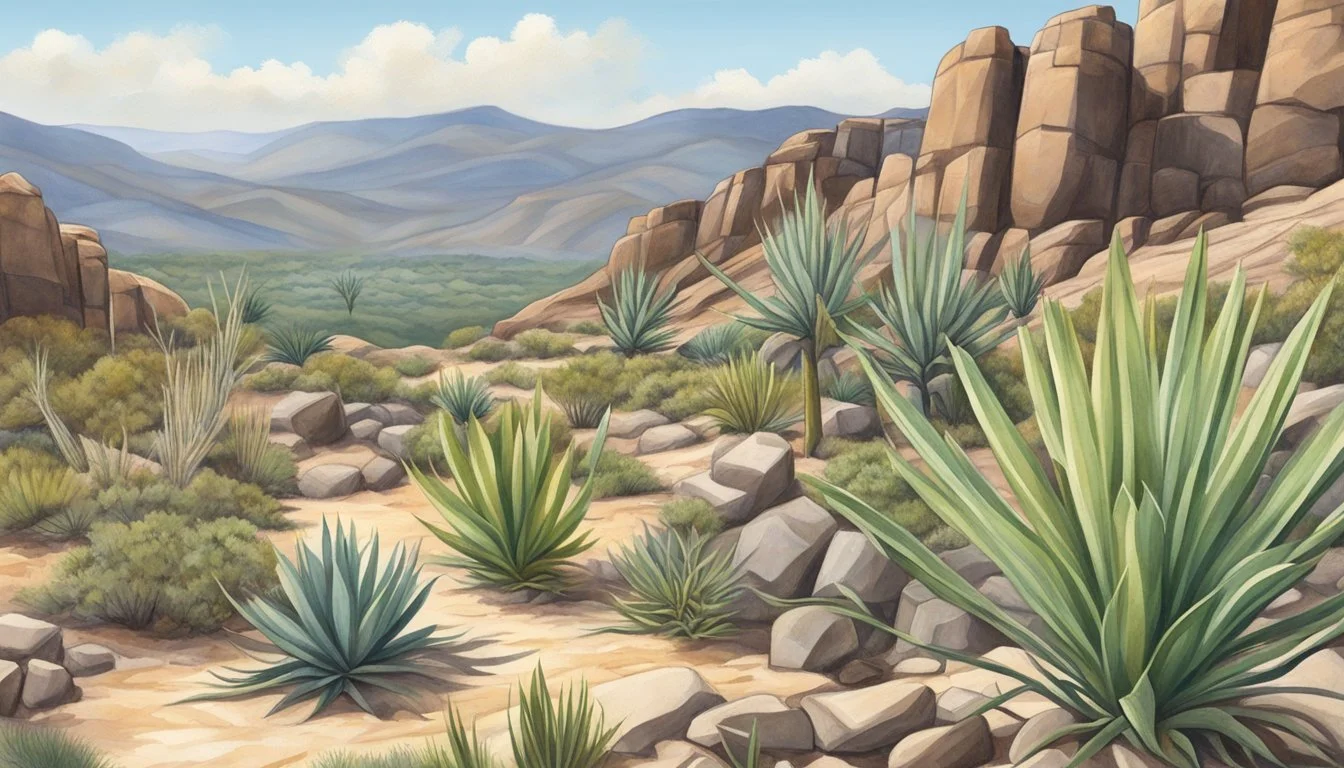Drought-Tolerant Plants in West Virginia
A Guide for Sustainable Gardening
In West Virginia, gardeners and conservationists alike are turning their attention to drought-tolerant plants as a means to sustain green spaces in the face of fluctuating weather patterns. These species thrive in challenging conditions by conserving water, allowing them to survive in drier climates and during periods of low rainfall. Incorporating plants like Eastern red columbine and Blue mistflower into local landscapes not only conserves vital water resources but also supports native wildlife, providing essential habitats and food sources.
The advantages of growing drought-tolerant plants in West Virginia extend beyond their low water needs. They are generally more resistant to diseases and pests, reducing the need for chemical interventions. Adaptable to the Appalachian region’s varied terrain, plants like the New Jersey tea and Honey bells are already well-suited to the environmental conditions, which makes them hardy additions to both private gardens and public restoration projects.
Moreover, the use of native, water-wise vegetation is an important step in maintaining the natural ecology of West Virginia. It prevents the spread of invasive species such as purple loosestrife and garlic mustard, which can disrupt local ecosystems. By selecting appropriate, drought-resistant plants, residents can ensure their gardens are both beautiful and beneficial to the state’s rich biodiversity.
Understanding Drought-Tolerant Plants
The focus on drought-tolerant plants has become essential in West Virginia, as these plants offer resilience against periods of low rainfall and are typically low-maintenance. This section delves into the specific adaptations that enable these plants to survive in arid conditions and the benefits they provide.
Adaptations of Drought-Tolerant Species
Drought-tolerant species have developed a range of physiological and physical adaptations to conserve water and thrive in dry climates. Key adaptations include:
Deep Root Systems: Some drought-tolerant plants have evolved to have deep root systems that can access water stored deep in the soil.
Reduced Leaf Area: To minimize water loss, these plants often have smaller leaves or leaves with a waxy coating that reduces evaporation.
Crassulacean Acid Metabolism (CAM): This is a specialized form of photosynthesis that allows plants to open their stomata at night to reduce water loss.
These adaptations may vary across different native plants, each evolved to meet the challenges of their unique ecosystems.
Benefits of Drought Tolerance
Drought-tolerant plants offer benefits that are especially valuable in today's changing climate:
Water Conservation: They require less watering, contributing to water conservation efforts.
Ecosystem Support: Native drought-tolerant plants support local wildlife and help maintain ecological balance.
Reduced Maintenance: Being low-maintenance, these plants require less care than more water-dependent species, saving time and resources.
By incorporating these native and adapted plants, one can create a sustainable and resilient garden in West Virginia's diverse climate.
Native Drought-Tolerant Plants of West Virginia
Adopting native drought-tolerant plants for landscaping in West Virginia supports local ecosystems and reduces water usage. These plants have evolved to thrive in the local climate and soil conditions, offering sustainability and resilience to local gardens.
Shrubs
New Jersey Tea (Ceanothus americanus): A hardy shrub that flowers with white clusters, ideal for dry, sandy soils. Honey Bells (Cephalanthus occidentalis): Also known as Buttonbush, it bears spherical white flowers and adapts well to various moisture levels.
Trees
Eastern Redbud (Cercis canadensis): A deciduous tree known for its vibrant pink flowers in early spring, it is tolerant to dry conditions once established. Black Gum (Nyssa sylvatica): Noted for its brilliant fall color, it's a tree that can survive well in dry, acidic soils.
Herbs
Mountain Mint (Pycnanthemum virginianum): This herb is appreciated for its fragrant leaves and tolerance to drought conditions. Wild Bergamot (Monarda fistulosa): With purple flowers that attract pollinators, it is a robust herb for variable soils.
Ornamental Grasses
Little Bluestem (Schizachyrium scoparium): It provides year-round interest with changing colors and is well-suited for dry, infertile soil. Indian Grass (Sorghastrum nutans): It is a tall grass with golden plumes and thrives in well-drained areas.
Flowering Plants
Eastern Red Columbine (Aquilegia canadensis): A self-seeding plant with red and yellow flowers, perfect for rocky, dry areas. Pink Milkweed (Asclepias incarnata): Essential for supporting monarch butterflies, it grows well in drought conditions once established.
For more details on native plants in West Virginia, the West Virginia Native Plant Society provides extensive resources and information.
Designing a Drought-Resistant Garden
Crafting a garden that thrives in drought conditions involves strategic planning, soil preparation, and effective water management. These components are crucial to establish a resilient landscape in West Virginia's varying climate.
Garden Layout and Design
When arranging a drought-resistant garden, one must consider the natural climate and topography of West Virginia. They should select native plants that are accustomed to the local weather patterns and soil types. Arranging plants with similar water needs together can minimize water use. The use of drought-tolerant perennials, annuals, and shrubs can create a lush appearance with minimal water input.
Full Sun Areas: Group plants that thrive in full sun and can tolerate dry conditions.
Shaded Areas: Utilize these cooler regions for plants that need protection from intense heat.
By segmenting the garden into zones based on sun exposure and plant requirements, one can design a sustainable and efficient landscape.
Soil Considerations
The soil in a garden significantly affects water retention and plant health. It's important to enrich the soil with organic matter to increase its water-holding capacity. Proper mulching is also vital; it conserves moisture, suppresses weeds, and maintains soil temperature. Soils should be tested for their composition—sandy soils drain quickly and may need organic amendments, while clay soils hold moisture longer but can become waterlogged.
Soil Amendment: Incorporate compost or other organic matter to improve soil structure.
Mulching: Apply a 2-3 inch layer of organic mulch to conserve water.
Irrigation Strategies
Efficient irrigation is key in a drought-resistant garden. One should employ methods that reduce water waste, such as drip irrigation or soaker hoses, delivering water directly to plant roots. Scheduling watering for the early morning or late evening minimizes evaporation. A rain barrel can be a valuable addition to capture and recycle rainwater for garden use.
Irrigation Methods: Drip systems or soaker hoses for targeted watering.
Water Timing: Irrigate during cooler parts of the day to reduce water loss.
By integrating these garden design concepts, soil practices, and irrigation strategies, one can achieve a beautiful and drought-resistant garden that aligns with the environmental conditions of West Virginia.
Planting and Maintenance
Proper planting and consistent maintenance are crucial for the success of drought-tolerant plants in West Virginia. These practices help establish a resilient garden that can withstand periods of low rainfall.
Planting Guidelines
One should plant during the correct growing season to ensure that plants have adequate time to establish root systems before periods of high stress, such as heat waves or droughts. In West Virginia, this typically means planting in the early spring or fall when temperatures are milder. Soil preparation is essential; amending the soil with compost can improve its ability to retain moisture and support healthy plant growth. Additionally, choosing the right location in the landscape that matches the plant's needs for sunlight and space will promote better growth and reduce the likelihood of disease.
Growing Season: Plant in early spring or fall.
Soil Preparation: Amend soil with compost for moisture retention.
Location: Match plant's sunlight and spacing needs.
Ongoing Care and Maintenance
Once plants are established, they require less water than non-drought-tolerant species, but that doesn't mean they're maintenance-free. Regular monitoring for signs of stress or disease can prevent larger issues. If diseases do appear, one should utilize eco-friendly insecticides and pesticides judiciously to manage these problems without harming beneficial insects or the environment. During the active growing season, occasional deep watering encourages deeper root growth which can further increase drought tolerance.
Monitoring: Regularly check for plant stress or disease.
Pest Management: Use eco-friendly insecticides and pesticides.
Deep Watering: Employ during the growing season to promote root growth.
Attracting Wildlife
Incorporating drought-tolerant plants into your West Virginia landscape is a sustainable approach to attract a diverse range of wildlife. Specific native plants not only survive in drier conditions but also support local ecosystems, bringing essential pollinators and other wildlife to your garden.
Beneficial Insects and Pollinators
For gardeners aiming to attract butterflies, including plants like the blazing star (Liatris spicata) and beardtongue (Penstemon spp.) can be particularly effective. These plants are known for their vibrant flowers and ability to thrive with minimal water. They serve as essential food sources for bees and butterflies, offering nectar and serving as host plants for their larvae.
Bees: Plant species such as New Jersey tea (Ceanothus americanus) which offer abundant flowers.
Butterflies: Incorporate milkweeds like the pink milkweed (Asclepias incarnata) to provide breeding grounds.
Birds and Small Mammals
Birds, such as hummingbirds, seek out trumpet creepers (Campsis radicans) because of their tubular blooms, making these plants an excellent choice for a bird haven. Other wildlife, including small mammals, benefits from plants like Eastern red columbine (Aquilegia canadensis) for their seeds and honey bells (Cephalanthus occidentalis) for shelter and food. Nesting birds and foraging animals are critical components of local biodiversity and their presence signifies a healthy environment.
Hummingbirds: Favor red or brightly colored tubular flowers providing high-energy nectar.
Small Mammals: Appreciate dense shrubs and ground covers that offer protection and food sources.
Environmental Impact
In West Virginia, the implementation of drought-tolerant plants is crucial to addressing water scarcity and protecting the region's rich biodiversity. Such endeavors also influence the balance between native and non-native species, with implications for ongoing development and land-use practices.
Water Conservation
Drought-tolerant plants significantly reduce water usage. By selecting species adapted to the local climate, West Virginia can conserve water resources. Low water use or drought-tolerant plants, as recommended by the U.S. Environmental Protection Agency, require minimal supplemental watering, thus supporting water conservation efforts in the region.
Biodiversity and Native Species
The introduction and preservation of native species are key to maintaining West Virginia's ecosystem health. Native plants, like the red spruce, which faces threats from climate change, are particularly important for the state's biodiversity. A study by Nicolas Zegre suggests significant climatic shifts in the Appalachian region, emphasizing the need to support native species that are adapted to the local environment, as seen in Climate Change Threatens a Giant of West Virginia's Landscape.
Non-native Species and Development
Non-native species can upset the ecological balance and outcompete local flora. Thoughtful development practices are crucial in preventing the spread of invasive plants. Strategic planning ensures that urban expansion and agriculture, such as West Virginia's hay production, don't encourage the proliferation of non-natives, potentially leading to water supply issues and disruption of local ecosystems. Information on the impact on agriculture can be gleaned from resources like What West Virginia's Changing Climate Means for Its Farmers.
Essential Plant Selections
Selecting the right plants for a drought-tolerant garden in West Virginia encompasses choosing species that have adapted to drier conditions. The focus here is on perennials and annuals that can withstand periods of low water, as well as succulents and cacti that are especially efficient in their water use. Additionally, an array of medicinal and culinary herbs offer both utility and resilience in the face of drought.
Perennials and Annuals
Coneflower (Echinacea spp.) is a hardy perennial that thrives with minimal watering. Its vibrant flowers attract pollinators and can endure hot, dry summers. Yarrow (Achillea millefolium) is another excellent choice, with its feathery foliage and clusters of flowers that come in a range of colors. For those seeking to support local ecosystems, Milkweed (Asclepias spp.) is indispensable as it is a host plant for the monarch butterfly. This plant stands resilient even during periods of limited rainfall.
Succulents and Cacti
In West Virginia's drier zones, gardeners can find success with various Sedum species, which store water in their thick, fleshy leaves. Types like Sedum telephium have the added benefit of providing year-round interest with their autumn-flowering habit. While not native, certain Aloe varieties can also be grown in pots and moved indoors during colder months, offering both drought tolerance and medicinal value.
Medicinal and Culinary Herbs
Herbs such as Oregano (Origanum vulgare) and Thyme (Thymus vulgaris) are not just flavorful culinary additions; they're also well-suited for drought conditions, needing only well-drained soil and full sun. Lavender (Lavandula) not only survives with little water but also brings a calming fragrance and purple blooms to the garden. These herbs, once established, become low-maintenance staples in a water-wise landscape.
Seasonal Considerations
When selecting drought-tolerant plants for West Virginia gardens, one must consider bloom time and growing season to ensure year-round color and interest.
Spring and Summer Blooms
Spring in West Virginia ushers in a period of vibrant growth. Plants such as the Wild blue phlox thrive, offering branches 8-18 inches tall with fragrant flowers in shades of lavender, pink, or purple. Their peak blooming occurs in late spring and can add a splash of color to any garden.
Summer is the time when drought-tolerant species prove their resilience. Perennials that perform well despite the heat, such as those mentioned in the Piedmont Master Gardeners Association survey, become focal points in the landscape. Plants that can withstand long periods without rain while still providing colorful blooms are essential for a successful, low-maintenance summer garden.
Autumn and Winter Interest
As the growing season progresses, the garden's color palette shifts. Autumn brings plants that offer late-season blooms or foliage that changes color dramatically. It's important to incorporate species that maintain their structure or offer ornamental seeds heads during the cooler months.
Winter, while often a dormant period for many plants, doesn't have to mean a lack of interest in the garden. Evergreens and plants with interesting bark or silhouette, including various native ornamental grasses, provide visual appeal. These species stand resilient against West Virginia's winters, keeping the garden dynamic even in the coldest months.
Supporting a Healthy Ecosystem
Drought-tolerant plants play a pivotal role in maintaining West Virginia’s ecosystems by providing crucial food sources and shelter for various species. They withstand the variances in weather, ensuring the continuity of this support.
Role in the Ecosystem
Drought-tolerant plants are integral to ecosystem stability in West Virginia. They conserve water and improve soil quality, making them essential during dry spells. Their deep root systems prevent soil erosion and maintain soil structure, which benefits not just the plants themselves but also the microorganisms that live in the soil. By doing so, they support life at multiple levels of the ecosystem.
Providing Food and Shelter
These resilient plants supply consistent food sources in the form of pollen and nectar, particularly important for pollinators like bees and butterflies. Through this, they encourage a biodiverse environment which is critical for a thriving ecosystem. Moreover, they offer shelter for wildlife, serving as a habitat for insects, birds, and small mammals. This not only protects these creatures but also aids in the pollination process, facilitating the growth of more plants and contributing to a robust ecosystem.
Challenges and Solutions
Drought-tolerant plants in West Virginia face a unique set of challenges compounded by regional climate shifts and pest pressures. Identifying effective solutions is essential for sustaining agricultural productivity and preserving the natural ecosystem.
Pests and Diseases
Pests and diseases can significantly impact drought-stressed plants as they tend to be more vulnerable to attacks. Insecticides and pesticides are often used to control these problems. Consistent monitoring for signs of infestations and diseases is imperative, along with employing integrated pest management strategies. For example, the use of drought-tolerant plant varieties can inadvertently affect the local pest population dynamics, as some pests might thrive in drier conditions.
Climate Challenges and Adaptations
Climates in West Virginia are changing, with trends indicating milder temperatures and altered precipitation patterns. Plant selections and agricultural practices must adapt to this new reality. Utilizing drought-resistant varieties, like those studied by West Virginia University, is crucial for resilience in the face of these shifts. Moreover, adopting water-efficient irrigation technology ensures that the moisture is conserved and optimally distributed throughout the crop fields.
Frequently Asked Questions
In West Virginia, selecting the right plants for landscaping can be crucial, especially when considering drought conditions. This section answers common inquiries about drought-resistant flora suited to West Virginia’s varied climate.
What are some native grasses in West Virginia that are resistant to drought?
Native grasses such as Little Bluestem (Schizachyrium scoparium) and Panicum (Panicum virgatum), often found in West Virginia, exhibit significant resilience to drought conditions.
Which native perennial plants thrive in West Virginia's dry conditions?
Perennials like the Butterfly Weed (Asclepias tuberosa) and Black-eyed Susan (Rudbeckia hirta) are known for their ability to withstand dry seasons in West Virginia.
Can you list drought-resistant evergreen plants suitable for West Virginia's climate?
Eastern Red Cedar (Juniperus virginiana) and Virginia Pine (Pinus virginiana) are evergreen selections that can adapt to the drier soils commonly found across parts of West Virginia.
What are the best wildflowers to plant in West Virginia that require minimal watering?
Wildflowers such as the Purple Coneflower (Echinacea purpurea) and Blanket flower (Gaillardia aristata) thrive with minimal watering and are excellent choices for water-efficient gardens in West Virginia.
How do I identify plants in West Virginia that are tolerant to low-water conditions?
Drought-resistant plants typically have deep roots, thick leaves, or grayish foliage. Agencies like Drought.gov provide valuable information about regional drought-resistant plants.
Are there medicinal plants native to West Virginia that can survive in dry soil?
Yes, medicinal plants such as Coneflower (Echinacea species) not only survive well in dry soil conditions but are also native to the West Virginia region.













